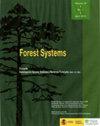Improving the accuracy of wood moisture content estimation in four European softwoods from Spain
IF 0.7
4区 农林科学
Q3 FORESTRY
引用次数: 1
Abstract
Aim of study: To obtain improved models to predict, with an error of less than ± 2.0%, the gravimetric moisture content in four different softwoods commonly present in the Spanish and European markets, based on electrical resistance measurements. This improved moisture content estimation is useful not only for assessing the quality of wood products, especially in the case of laminated products, during the transformation and delivery process, but also for accurately monitoring the evolution of moisture in wood present in bridges and buildings, which is of great importance for its maintenance and service life improvement.Area of study: The study was carried out on samples of Scots, laricio, radiata and maritime pines of Spanish provenances.Material and methods: On 50x50x20 mm3 solid wood samples (36 per species, 9 per condition), conditioned at 20ºC (±05ºC) and 40±5%, 65±5%, 80±5% or 90±5% Relative Humidity (RH), electrical resistance and oven-dry moisture content was measured. The Samuelsson's model was fitted to data to explain the relationship between the two variables. The accuracy of the model was evaluated by the use of an external sample.Main results: With the proposed mathematical functions the wood moisture content can be estimated with an error of ±0.9% in the four species, confirming the effectiveness of this nondestructive methodology for accurate estimation and monitoring of moisture content.Research highlights: our results allow the improvement of the moisture content estimation technique by resistance-type methodologies.Keywords: Resistance-type moisture meter; species correction.Abbreviations used: MC: Moisture content; RH: relative Humidity; R: electrical resistance; RP: wood electrical resistance measured parallel to the grain; RT: electrical resistance measured perpendicular (transversally) to the grain; GM-MC: gravimetrically measured moisture content.提高西班牙四种欧洲软木木材含水率估算的准确性
研究目的:根据电阻测量,获得改进的模型,以预测西班牙和欧洲市场上常见的四种不同软木的重量水分含量,误差小于±2.0%。这种改进的含水量估计不仅有助于评估木材产品的质量,特别是在层压产品的情况下,在改造和交付过程中,而且有助于准确监测桥梁和建筑中木材中水分的演变,这对其维护和使用寿命的提高非常重要。研究领域:这项研究是在西班牙种源的苏格兰松、落叶松、辐射松和海松的样本上进行的。材料和方法:在50x50x20 mm3的实木样品(每种36个,每种条件9个)上,在20ºC(±05ºC)和40±5%、65±5%、80±5%或90±5%相对湿度(RH)条件下,测量电阻和烘干含水量。萨缪尔森模型被拟合到数据中,以解释这两个变量之间的关系。通过使用外部样本来评估模型的准确性。主要结果:利用所提出的数学函数,可以估计四种木材的含水量,误差为±0.9%,证实了这种无损方法在准确估计和监测含水量方面的有效性。研究重点:我们的研究结果允许通过电阻型方法改进含水量估计技术。关键词:电阻式湿度计;物种矫正。使用的缩写词:MC:水分含量;RH:相对湿度;R: 电阻;RP:平行于纹理测量的木材电阻;RT:垂直于(横向)晶粒测量的电阻;GM-MC:用重量法测得的水分含量。
本文章由计算机程序翻译,如有差异,请以英文原文为准。
求助全文
约1分钟内获得全文
求助全文
来源期刊

Forest Systems
FORESTRY-
CiteScore
1.40
自引率
14.30%
发文量
30
审稿时长
6-12 weeks
期刊介绍:
Forest Systems is an international peer-reviewed journal. The main aim of Forest Systems is to integrate multidisciplinary research with forest management in complex systems with different social and ecological background
 求助内容:
求助内容: 应助结果提醒方式:
应助结果提醒方式:


